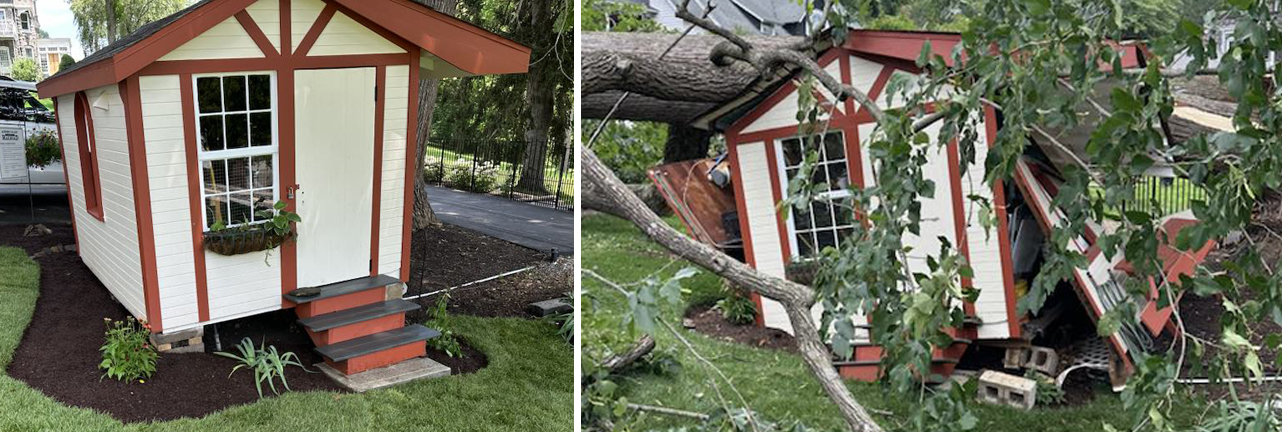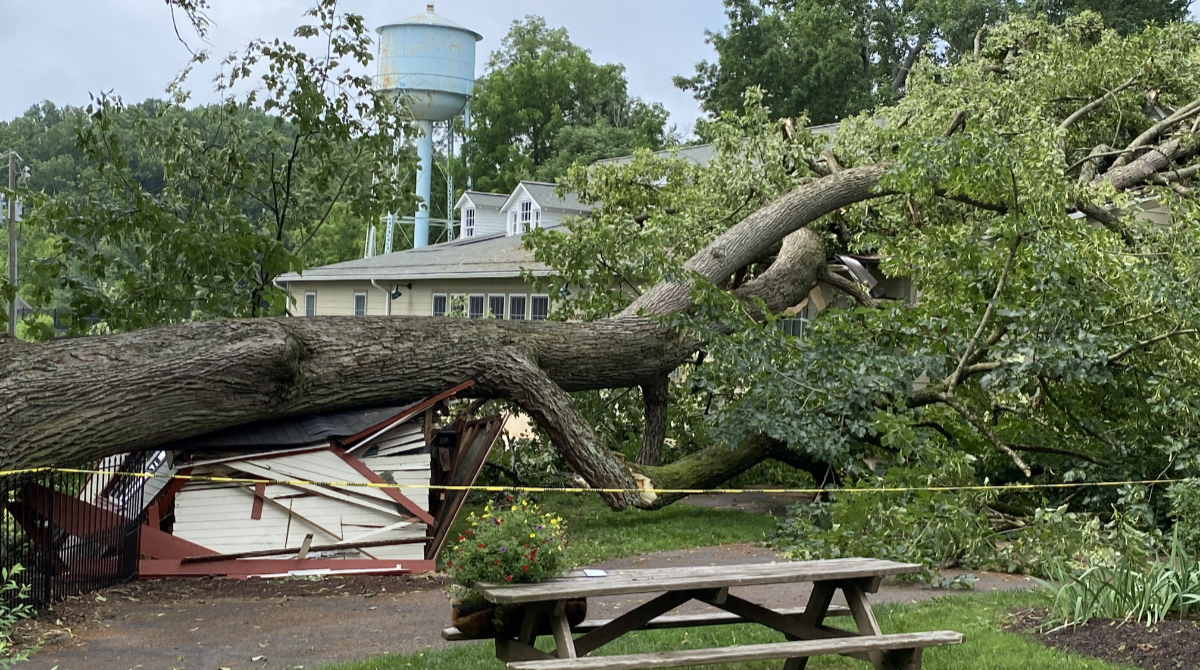West Yorklyn Station

When Mother Nature Gets Cranky
In the wee hours of Saturday, June 28, the towering Linden tree by West Yorklyn Station came down onto the station and museum.
The little building boasts quite the history, having been a playhouse and then home to two different men during the 1930s before being adapted into a station for the Auburn Valley Railroad when it debuted in 1960. In recent years the station provided much-needed storage for the little railroad and had just undergone a complete makeover, with refreshed facia, paint and landscaping — just in time to show off its new appearance at the July Steamin’ Day until Mother Nature intervened.
We managed to salvage the walls and windows from the little station (erected as Tom Marshall’s playhouse in the 1930s). Miraculously, only one windowpane was broken, though the north wall and roof were badly crushed. Rest assured, the little station shall rise again! To learn more about its illustrious history, see below, including a link to donate toward its restoration.

History of West Yorklyn Station (as told by Tom Marshall in the Weekly News, February 14, 2011)
The prefabricated “camping out” house, sold by a Minnesota company for $98 in the early 1930s (we have the original catalog) was advertised as being highly preferable to a tent. Ours was ordered by my father and erected, turned 180 degrees from its present orientation, as a playhouse for me and my friends. It was equipped with screens on the windows, a folding table, and benches that hinged to the wall. There was room for two or three small cots. Although I can remember the many fun times my friends and I had “playing house” and several meals eaten there, I can recall only one overnight stay. The Mancill twins and I looked forward to this, away from the care of our parents. We were making out well until my dad showed up about 8:30, concerned that we shouldn’t be there alone all night. I don’t know how we all fit, but he moved in, and four of us slept there until morning.
About two years later, a hired man named Bill Tate worked at Auburn Heights through one winter and spring. The little house was insulated with newspaper stuffed in the cracks, and Bill lived there with a small electric heater and an electric hot plate (stovetop). He walked to the garage for his bathroom, with a makeshift shower being installed in a back corner. The little house soon took on the aroma of Bill’s pipe, but the arrangement seemed to work out well. By late spring, however, Bill’s employment was terminated. I hated to see him go; 10-year-olds didn’t understand such things.
The next tenant was William H. Whorl. Bill was an orphan from upstate New York who, at age 22, came to Delaware seeking work. He, too, was hired as an outside man to assist “Cliffey” (Clifford Murray) and lived in the boardinghouse near the Yorklyn bridge. Bill fit in well wherever he was and got along fine with the bachelors living there, most of whom worked for the snuff mills. When the boardinghouse was torn down in 1937, Bill moved into the tiny playhouse. He lived there over a year and, on his meager wages, bought an Indian Motorcycle. As the mills got busier leading up to World War II, Bill went to work for National Fibre, where the pay was considerably better, and he married about 1940. He was in the service during World War II, and we corresponded when both of us were far from home. Following the war, my mother encouraged Bill to start a small nursery and lawn care business, as she had recognized his abilities along those lines. He was just getting started when he was killed in an automobile accident at the age of 33.
When the first Auburn Valley Railroad was built in 1960, the right-of-way came right alongside the little building. Still in its original location, Paul Wollaston built a lean-to overhang on the track side and enlarged the window thereunder so the building could be a ticket office. We called it West Yorklyn Station. About 30,000 Auburn Valley tickets were sold from this window between 1961 and 1965. When the Magic Age of Steam began in 1971, the building was rotated 90 degrees, with the ticket window then facing the mansion, and tracks came by on both sides. Tickets were sold both at the front gate and from this window. Finally, as the Auburn Valley came into current use about 15 years ago, the building was rotated another 90 degrees with the thought that the ticket window would be facing the present tracks, as the “upper line” had been abandoned. Unfortunately it has not been used as a ticket office in recent years.
